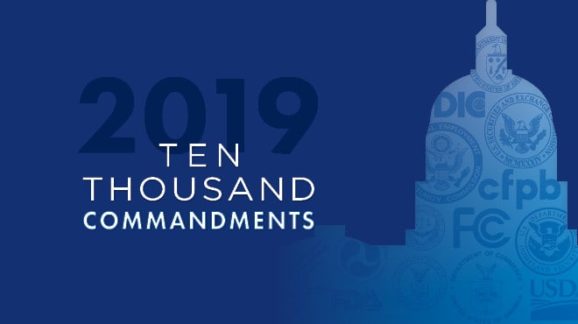Federal Government Illegally Fails to Account for at Least $1.9 Trillion in Estimated Regulatory Costs

The Competitive Enterprise Institute (CEI) today released the 2019 edition of Ten Thousand Commandments: An Annual Snapshot of the Federal Regulatory State (10KC 2019), CEI’s annual survey of the size and scope of the federal regulatory burden.
For decades, the federal government has failed to provide a legally required accounting of the regulatory costs it imposes on the rest of us. To address that problem, CEI Vice President for Policy Wayne Crews compiles a cost estimate of $1.9 trillion annually, based on available sources, from governmental to academic to industry. That amounts to about 43 percent of fiscal budget outlays, of $4.412 trillion, and more than double the anticipated deficit, expected to soar to $897 billion. This is a conservative estimate, considering the vast information gaps in government reporting and the difficulty in quantifying more intangible costs, such as loss of freedom, regulatory uncertainty for entrepreneurs and businesses, and harms regulation can cause.
“Despite the progress made on regulatory reform under President Trump, American consumers and businesses are still on the hook for the ‘hidden tax’ of federal regulation,” said Crews. “And that progress is further threatened by President Trump’s own regulatory impulses on issues ranging from antitrust enforcement to trade restrictions to food and drug matters, and more.”
Ultimately, this lack of regulatory transparency needs to be addressed by the government itself. Congress should vote on major rules and the executive branch should conduct the periodic costs assessments it has long been required but failed to do.
“Since a divided Congress is unlikely to pass legislation, President Trump can keep his regulatory reform agenda on track by ignoring his own discordant impulses to increase certain kinds of regulation and taking executive action to compel all federal regulators to put out an annual regulatory report card,” said Crews. “He should also sign another order implementing a regulatory cost budget to help induce Congress to act and address misuse of guidance documents.”
Highlights in the 2019 edition of Ten Thousand Commandments include:
- The estimated $1.9 trillion “hidden tax” of regulation is greater than the corporate and personal income taxes combined. If the cost of federal regulations were a country, it would be the 9th largest, behind India and just ahead of Canada.
- Each U.S. household’s estimated regulatory burden is at least $14,600 annually on average. That amounts to 20 percent of the average pre-tax household budget and exceeds every item in that budget, except housing.
- In 2018, the Trump administration issued 3,368 rules. That’s more than the 3,281 final rules in 2017, which was the lowest number of regulations coming out of federal agencies in a single year since the National Archives began publishing rule counts in 1976.
- The estimated regulatory cost burden is equivalent to more than 40 percent of the level of total federal spending, projected to be $4.4 trillion in 2019.
- In 2018, Washington bureaucrats issued regulations at a rate of 11 for every one law Congress enacted. The average for this “Unconstitutionality Index” for the past decade has been 28 to one. The five agencies issuing the most rules are the Departments of Commerce, Defense, Health and Human Services, Transportation, and the Treasury.
- President Trump should ignore his regulatory impulses on issues like antitrust, social media and technology, infrastructure, trade restrictions, telecommunications, food and drugs, subsidies, and more. Given divided government and the absence of Congressional action, the president should use executive orders to compel regulatory agencies to: put out an annual regulatory report card, implement a regulatory cost budget to keep his reform agenda on track, and address the misuse of agency guidance documents.
See the 2019 edition of 10KC here.